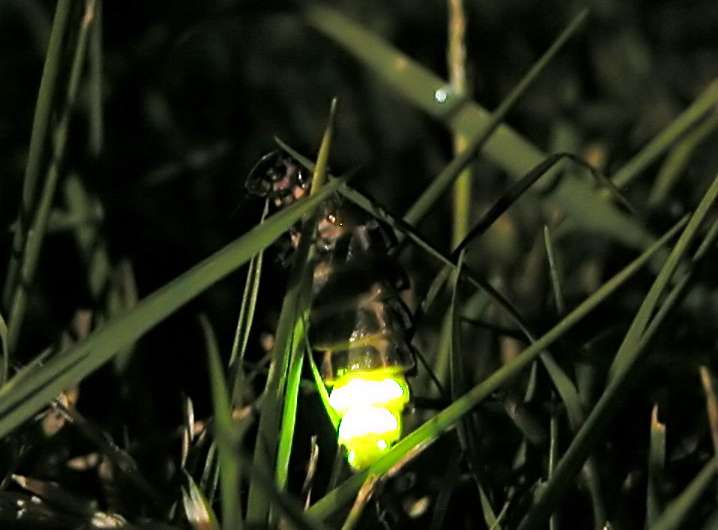October 21, 2015 report
Female glowworms with brighter lights found to attract more mates and to produce more offspring

(Phys.org)—A small team of researchers affiliated with the University of Oulu and the University of Helsinki, both in Finland, has found that female glowworms that have a brighter light tend to attract more mates and to produce more offspring. In their paper published in the journal Biology Letters, the team describes their two-pronged research project and what they learned in studying the common beetle.
Glowworms, also known as lightening bugs, are very well known in many parts of the world—masses of them at night giving off their eerie green light can sometimes resemble moving stars. One particular type of glowworm, Lampyris noctiluca lives in parts of Tvärminne research station and Nurmijärvi, both in Finland, which naturally led the researchers to focus on them. They note that females of the species cannot fly or eat, they simply hang around glowing until a male drops by to mate with them—afterwards, they stop glowing, lay eggs and then die. What the team wanted to know was, does the amount of glow given off by a female have any real impact on her attractiveness to males, or the number of offspring she would have. If so, it would offer a rare example of female ornamentation for attraction of males, rather than the usual other way around.
To find out, the researchers set up two experiments, the first involved capturing a number of females that were believed to be glowing for the first time and bringing them into the lab for scrutiny. In the lab, the researchers replicated outdoor conditions by turning the lights off at night. Each specimen was measured to see how large her lantern was and the number of eggs she laid was counted. Afterwards, each was dissected to count the number of eggs in her ovaries to derive a total possibility of offspring.
The second experiment involved setting up artificial females out in a field and then varying the intensity of light generated to see how it impacted the interest of males.
The team finished by comparing attraction rates of males to light intensity with lantern size in females and the number of potential offspring produced. They found that those females with larger lanterns, which allowed them to emit more light, attracted many more mates and also produced more offspring—those with the largest lanterns produced up to four times as many eggs as the smallest.
More information: I'm sexy and I glow it: female ornamentation in a nocturnal capital breeder, Biology Letters, Published 21 October 2015.DOI: 10.1098/rsbl.2015.0599
Abstract
In many species, males rely on sexual ornaments to attract females. Females, by contrast, rarely produce ornaments. The glow-worm (Lampyris noctiluca) is an exception where wingless females glow to attract males that fly in search of females. However, little is known about the factors that promote the evolution of female ornaments in a sexual selection context. Here, we investigated if the female ornament of the glow-worm is a signal of fecundity used in male mate choice. In support of this, we found brightness to correlate with female fecundity, and males to prefer brighter dummy females. Thus, the glow emitted by females is a reliable sexual signal of female fecundity. It is likely that male preference for the fecundity-indicating ornament has evolved because of large variation among females in fecundity, and because nocturnal males cannot directly assess female size and fecundity. These results indicate that female ornamentation may evolve in capital breeders (i.e. those in which stored resources are invested in reproduction) when females vary significantly in fecundity and this variation cannot be assessed directly by males.
Journal information: Biology Letters
© 2015 Phys.org





















